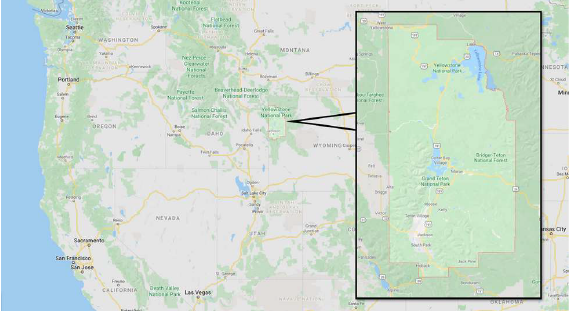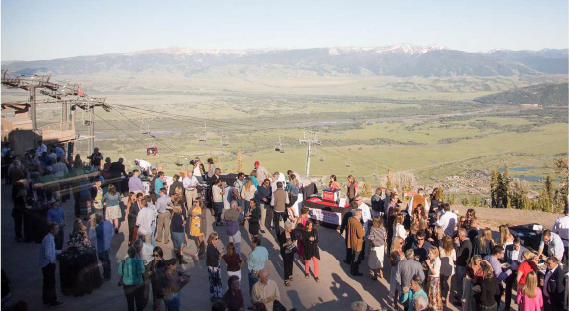-
About
-
What we do
CERTIFICATION
TRAINING
ADVISORY
Sustainable DestinationsSustainable Businesses (ESG) -
Resources
EARTHCHECK RESOURCES

Teton County, located in the state of Wyoming in northwest of the United States of America (U.S), is also known as the tourism destination Jackson Hole. The region encompasses 10,919 square kilometers including all of Grand Teton National Park, 40.4% of Yellowstone National Park’s total area and three ski resorts. These parks are part of the Greater Yellowstone Ecosystem (GYE) one of the last remaining large, nearly intact ecosystems in the northern temperate zone of the earth.
Yellowstone National Park was the first national park in the U.S. and is also the first national park in the world. It spans an area of 8,983 square kilometers and is in three states – Wyoming, Montana and Idaho. It comprises lakes, canyons, rivers and mountain ranges, including Yellowstone Lake, one of the largest highelevation lakes in North America. The park was named a UNESCO World Heritage Site in 1978. It is known for its abundant wildlife or megafauna – moose, grizzly and black bears, wolves, bison and elk live in this park – and its many geothermal features (half of the world’s geysers and hydrothermal features are in Yellowstone).
Only 16 kilometers south of Yellowstone is Grand Teton National Park, named after Grand Teton, the tallest mountain in the Teton Range. The park includes the major peaks of the 64 kilometers long, Teton Range and most of valley known as Jackson Hole. Grand Teton National Park is connected to Yellowstone National Park via the John D. Rockefeller, Jr. Memorial Parkway, a scenic road owned and managed by the National Park Service. Grand Teton National Park is an almost pristine ecosystem and the same species of flora and fauna that have existed since prehistoric times can still be found there.
The year-round population of Teton County is approximately 23,500 and during the summer peak months the population grows to almost 68,000. Annual visitation to Teton County is over 4 million domestic and international overnight visitors and generates US$1.23 billion in annual revenue.
As a popular tourism destination, Teton County features over 11,000 beds of diverse accommodations, restaurants, retailers, and tours and activities such as hiking, fishing, mountaineering, camping, mountain biking, horseback riding, kayaking, rafting, and skiing at any of the three ski areas: Snow King, Jackson Hole Mountain Resort and Grand Targhee.

In 2012, Teton County participated in the Global Sustainable Tourism Council (GSTC) Early Adopters Program for Sustainable Destinations. The GSTC’s concluding remarks were that “Teton County more than any other place in the world had the potential to become a leader as a sustainable destination”.
One of the most important findings of the Early Adopters assessment was that, despite a plethora of stakeholders working with the best intentions to increase the sustainability of the County, there was no coordination or unified approach towards shared goals and international standards for sustainability. Therefore, in 2014 the Jackson Hole & Yellowstone Sustainable Destination Program (the Program) was established by the Riverwind Foundation. One of the primary objectives of the Program was to achieve thirdparty certification within five years.
The purpose of seeking certification was to guide and drive sustainability innovation and improvement with Teton County’s business, government, and nonprofit stakeholders and the overall community.
When it came to selecting a certification program, “We selected EarthCheck’s Sustainable Destinations program due to it being the longest running and most rigorous certification process we could find” said Timothy O’Donoghue, Executive Director at the Riverwind Foundation and EarthCheck Destination Coordinator.

The EarthCheck Destination Coordinator organized and coordinated a core team of six volunteers (the Riverwind Foundation’s Destination Certification Team) who collected data and supporting documentation from 44 individuals and 16 partnering organizations. The team researched, gathered, and uploaded plans, policies, data, reports and other information related to sustainability into a cloud-based platform with a master index organized according to the EarthCheck Benchmarking Indicators for destinations.
The result: the most comprehensive library and database of sustainability related information ever created for Teton County. This library and database is now publicly available to any individual or organization that is searching for current and historical sustainability documentation and data. This database enables the community to share knowledge, resources and enhance capacity based on shared goals.
The accumulated volunteer time totaled 846 hours and the Riverwind Foundation has maintained all original volunteers and even grown its dedicated team! Whilst it was a timely process to gather the relevant documentation, the engagement from the community during this time not only supported the required processes from a certification perspective, but also achieved buy-in to the broader sustainability goals and objectives for the region and created momentum across the region. This was a critical step.

Through stakeholder meetings and engagement with EarthCheck’s Destination Coordinator, a policy was developed that effectively balanced the needs of stakeholder groups. This was acknowledged and signed by the Mayor of the Town of Jackson and signaled a milestone in the progress towards certification.
As part of the program, Teton County is required to measure, monitor and make ongoing improvements in the key performance areas outlined below:
Teton County’s GHG emissions were steadily on the rise since 2009, largely due to increased local and visitor transportation. Nonetheless, the Jackson Town Council approved a resolution to reach net zero emissions by 2030. To achieve this, the destination is planning to move away from single occupancy vehicles and implement an integrated transport system that allows for ridesharing, walking and biking. A local private sector organization called the Jackson Hole Climate Action Collective was established in 2019 to support this goal.
Over 90% of electricity to Teton County comes from renewable sources, which includes 10.5% from certified renewable energy. The local energy cooperative, Lower Valley Energy, has joined with local government to establish Energy Conservation Works, a joint powers board that conducts energy efficiency and conservation programs, and promotes the use of green energy to residential and commercial consumers.
Yellowstone-Teton Clean Cities is an organization that promotes the use of alternative fuels for vehicles and transportation. Teton County is planning to reduce energy usage by 40% by the end of 2020.
Although the supply of highquality freshwater sources is abundant in Teton County, potential climate change impacts require community wide water conservation programs and strategies. A coalition of conservation organizations named Protect Our Waters was created to advocate for clean water policy and programs, including resident education and septic system improvement initiatives. The goal is to reduce energy usage from water use by 20% by 2020. More qualitatively, the goal is to reduce nutrient pollution to improve quality of waterways.
The Jackson Town Council and Teton County Commissioners approved a resolution in 2014 for Teton County to be a Zero Waste Community.
In addition, Grand Teton National Park partnered with Subaru and the National Parks Conservation Association in the Zero Landfill Initiative. Integrated Solid Waste & Recycling coordinates the solid waste management facilities and programs of the destination, including the initial community composting facility. Teton County’s goal is 60% diversion from the landfill by 2030.
In addition to the goals cited above: the establishment of a destination management organization – Destination Stewardship Council – consisting of representatives from diverse segments of the community. “This organization or council shall oversee the development and implementation of the destination management plan that prioritizes environmental stewardship and social responsibility and responds to the sentiments of residents and visitors”, continued O’Donoghue.
Communication of sustainability credentials since tourism operators have a great opportunity to engage with the millions of visitors who pass through the region annually. Ensuring that this story is shared is an important part of the sustainability journey.
Working with our key stakeholders to not only apply a sustainability focus to the County, but also to tourism businesses individually. Utilising the skills and knowledge we have learnt through the certification program to build capacity among our operators, build resilience into the destination, and realize Teton County’s vision to be a worldleading sustainable community and destination.

There are more than 476 million Indigenous Peoples, found in all regions of the world, from the Arctic to the tropical forests. They make up more than 6 per cent of our global population.
In the spirit of reconciliation, EarthCheck acknowledge the Traditional Custodians of Country throughout the world and their connections to land, sea and community. We pay our respect to their Elders past and present and extend that respect to all Indigenous Peoples today.
EarthCheck acknowledges that Indigenous Peoples are guardians of the forests and biodiversity hotspots we all depend on. Research shows that lands managed by Indigenous Peoples, with secure rights, experience lower deforestation rates, store more carbon, hold more biodiversity, and benefit more people than other lands — including protected areas.
We recognise and support the United Nations Declaration on the Rights of Indigenous Peoples (UNDRIP), the most comprehensive international instrument on the rights of Indigenous Peoples. The Declaration is a positive document that maps out a path for Indigenous Peoples to be free from discrimination and secure in their identities and life choices.
EarthCheck science and products were developed by the Australian Government Sustainable Tourism Co-operative Research Centre (STCRC) over ten years. Our science is reviewed annually to ensure that it meets international standards relative to greenhouse gas protocols, responsible tourism, and certification.
EarthCheck products and services are built on the Agenda 21 principles for Sustainable Development endorsed by 182 Heads of State at the United Nations Rio De Janeiro Earth Summit in 1992 and aligned to the SDGs.
EarthCheck Certified provides a framework for organisations to achieve the desired outcomes for sustainable development as set out in the final report of the World Summit for Sustainable Development held in Johannesburg in 2002.
EarthCheck Certified complies with the Mohonk Agreement (2000), which outlines the guidelines and principles for an international sustainable tourism certification program. It is also a Recognised program of the Global Sustainable Tourism Council (GSTC).
EarthCheck Certified is a verification standard accepted by CDP. It is also an approved program of the Certification and Accreditation Administration of the People’s Republic of China (CNCA), London & Partners, the Mexican Secretary of Tourism (SECTUR) and the City of Sydney.
EarthCheck Certified is an approved program for meeting the EU Energy Directive for the Federal Office for Economic Affairs and Export Control (Bundesamt für Wirtschaft und Ausfuhrkontrolle – BAFA) in Germany and the Netherlands Enterprise Agency (Ministry of Economic Affairs and Climate Policy) in the Netherlands.
EarthCheck partners with international research organisations to maintain the currency of EarthCheck science and our benchmarking systems.
The EarthCheck brand signifies scientific excellence, better environmental, economic, and social performance, improved community interactions, and savings through more efficient use of resources. It provides recognition and promotional support to a global consumer market.